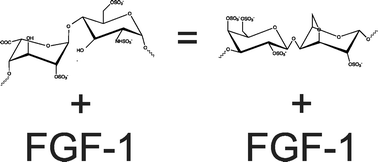The activities of heparan sulfate (HS) and heparin do not correlate simply with sulfation levels or sequence. The alternative hypothesis, that appropriate charge and conformational characteristics for protein binding and activity can be provided by other sequences in heparan sulfate and, possibly, also in unrelated sulfated polysaccharides, is explored. Differential scanning fluorimetry was used to measure the thermostabilisation bestowed by modified heparin polysaccharides (proxies for heparan sulfate) on fibroblast growth factor-1 (FGF-1) and fibroblast growth factor-2 (FGF-2), prototypical heparan sulfate-binding proteins, revealing varied abilities and primary sequence-activity redundancy. The effect of substitution pattern on the heparin/heparan sulfate backbone was explored using principal component analysis of 13C NMR chemical shift data for homogeneously modified heparin polysaccharides revealing complex conformational effects. No simple relationship emerged between these polysaccharides, with their distinct charge distributions and geometries, and their ability to signal. Other, structurally unrelated sulfated polysaccharides were also able to support signalling. These influenced FGF stabilisation in a similar manner to the HS analogues and provided analogous cell signalling activity. For FGF-1, but not FGF-2, signaling correlated strongly with protein stabilisation and circular dichroism spectroscopy demonstrated that some non-HS polysaccharides invoked comparable secondary structural changes to those induced by heparin. Active conformations can readily be found in several heparin derivatives, as well as among non-HS polysaccharides, which comprise unrelated primary sequences, confirming the hypothesis and implying that the level of unique information contained in HS sequences may be much lower than previously thought.

You have access to this article
 Please wait while we load your content...
Something went wrong. Try again?
Please wait while we load your content...
Something went wrong. Try again?


 Please wait while we load your content...
Please wait while we load your content...